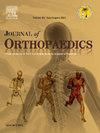Non-screw glenoid augmentation constructs for shoulder instability with bone loss: A biomechanical assessment of static and elastic cerclage constructs
IF 1.5
Q3 ORTHOPEDICS
引用次数: 0
Abstract
Purpose
This study aims to compare the biomechanical performance of elastic and static suture-based cerclage systems to traditional screw constructs in the setting of modeled glenoid bony augmentation.
Methods
Biomechanical testing was conducted on polyurethane cellular foam blocks modeling a 20 % glenoid defect repaired with a coracoid graft. Constructs consisted of an elastic suture-based cerclage, static suture-based cerclage, and a two-screw construct. Biomechanical testing was performed on material testing system, using a 7-phase, 100 cycle per phase, 1Hz, sinusoidal cyclic loading protocol, following a stair-step pattern in load control. Failure for cyclic loading was assessed at 0.8 mm linear displacement. The absolute end level for load-to-failure was 7.0 mm.
Results
Static suture-based cerclage failed at 5–50 N (Cycles 2 through 4), 2-screw constructs failed at 25–50 N (Cycle 4), and elastic suture-based cerclage failed at 100–200N (Cycles 6 and 7). Elastic cerclage exhibited superior performance compared to static cerclage beginning in Cycle 2 (p = 0.0440) and compared to SOC 2-screw construct beginning in Cycle 4 (p = 0.0118). 2-screw construct exhibited superior stability performance compared to static cerclage beginning in Cycle 3 (p = 0.0001). Elastic cerclage reached failure at 558.141 ± 4.508 N, while 2-screw construct and static cerclage reached failure at 422.009 ± 24.998 N and 366.770 ± 66.653 N, respectively. Elastic cerclage demonstrated superior biomechanical stability in load-at-failure performance to static cerclage (p < 0.0001) and the screw construct (p < 0.0001), while static cerclage demonstrated inferior biomechanical stability to the screw construct (p = 0.0343).
Conclusion
This biomechanical study comparing the performance of elastic cable and static suture tape cerclage fixation methods identified that the elastic cable cerclage exhibits a higher load-at-failure and less displacement under repetitive stress. In addition, elastic cable cerclage fixation exhibits greater strength and construct rigidity than traditional metal screw fixation.
求助全文
约1分钟内获得全文
求助全文
来源期刊

Journal of orthopaedics
ORTHOPEDICS-
CiteScore
3.50
自引率
6.70%
发文量
202
审稿时长
56 days
期刊介绍:
Journal of Orthopaedics aims to be a leading journal in orthopaedics and contribute towards the improvement of quality of orthopedic health care. The journal publishes original research work and review articles related to different aspects of orthopaedics including Arthroplasty, Arthroscopy, Sports Medicine, Trauma, Spine and Spinal deformities, Pediatric orthopaedics, limb reconstruction procedures, hand surgery, and orthopaedic oncology. It also publishes articles on continuing education, health-related information, case reports and letters to the editor. It is requested to note that the journal has an international readership and all submissions should be aimed at specifying something about the setting in which the work was conducted. Authors must also provide any specific reasons for the research and also provide an elaborate description of the results.
 求助内容:
求助内容: 应助结果提醒方式:
应助结果提醒方式:


